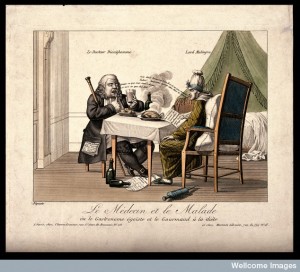By Lisa Smith, W&M Contributor
In December 1718, Dr. Tolozé, who styled himself an ‘Ancien Medecin’ (Old Doctor), wrote to physician Étienne-François Geoffroy.[1] Tolozé wanted Geoffroy to settle a dispute between him and the nuns of St. Eutrope near Chartres. Geoffroy, he believed, was well-placed to help, being the doctor of a Mme Cossins who had two daughters in the convent. This was of particular interest to Tolozé since one of Mme Cossins’ daughters was the convent apothecary.
Tolozé insisted that the nuns had been nothing but trouble since he had taken over as the convent physician four years previously. In part, he suggested, the problems stemmed from the previous doctor’s care. The last doctor had disliked blood-letting and instead encouraged the use of wine and cordials in his treatments. Tolozé preferred to prescribe tisanes, proclaiming liquor “hardly suitable.”
But the issue of blood-letting was at the heart of the dispute. Tolozé complained:
I find that these religious Ladies have much repugnance to bleeding, and above all the aforementioned Dame apotiquairesse who stands in the way of it very often and at just the wrong moment, to this Evacuation and to other remedies that she hardly knows.
To make matters worse, the nuns were increasingly resistant to being bled, following the recent deaths of three elderly nuns—including the Mother Superior: “These Ladies by an Error and a badly founded suspicion dared to attribute the death of their mothers to the bleeding.”
Tolozé believed that the real problem was that the patients had not been bled sufficiently to cure their chest ailments. He asked for Geoffroy’s advice in reviewing these cases, including the question of the usefulness of blood-letting and the “damnable” use of wine in treating chest ailments. Tolozé noted that the nuns believed wine was helpful: the “reason is that it fortifies.” He continued, though, “it is certain that one has advanced the death of all these nuns by this liqueur.”
The case had made him doubt his ability to manage the health of the nuns of St. Eutrope successfully. As he wrote:
If there is a doctor who is mortified it is me Monsieur, who has an Experience of thirty years. I protested to them that I would write to Paris today . . .. I beg you to give me this grace, and to make known to these good Ladies that they are making a very dangerous error. They have forgotten that in 1696 there were ten nuns who died in a short period when they were not bled because their ordinary doctor did not know the importance of this healthful and efficacious evacuation.
Tolozé had two major grievances, the dismissal of his medical skills and being blamed for killing three patients. Where he thought Geoffroy might help, though, was in persuading the convent apothecary to stop opposing his medical advice. The dispute was perhaps not so much a matter of female apothecary against male physician as a case of both physician and apothecary claiming the role of expert. Tolozé may have been an ‘Ancien Medecin’, but the apothecary had her own experience, which had not been contested by the previous physician whose remedies she continued to use.
Tolozé also wanted help in managing his unruly patients, but revealed his low tolerance for anything that deviated from his demands. When it came to wine, for example, “they say they take only a little. I retort to them that a little is always harmful.” But refusal to comply with his demands made sense to the nuns; since at least 1696, they had followed a very different regimen to the one prescribed by Tolozé. And who wouldn’t prefer to drink a bit of wine and avoid bleeding?
I have no idea what Geoffroy’s reply was. However, what Tolozé didn’t seem to understand was that he was demanding that the nuns alter ther whole understanding of health—a big ask after only four years of treating them! For Tolozé, the uncooperative patients undermined his authority; for his patients, his thirty years of experience did not automatically make him the expert.
[1] Bibiliothèque Interuniversitaire de Santé, Paris, MS 5244, ff. 216-217.
Lisa Smith is an Associate Professor of History at the University of Saskatchewan. She writes on gender, family, and health care in England and France (ca. 1600-1800). She also blogs weekly on history of medicine and science at her Sloane Letters Blog and edits The Recipes Project. She tweets as @historybeagle.

